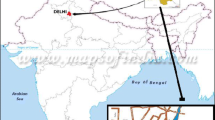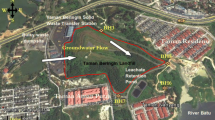Abstract
Assessment of chemistry of groundwater infiltrated by pit-toilet leachate and contaminant removal by vadose zone form the focus of this study. The study area is Mulbagal Town in Karnataka State, India. Groundwater level measurements and estimation of unsaturated permeability indicated that the leachate recharged the groundwater inside the town at the rate of 1 m/day. The average nitrate concentration of groundwater inside the town (148 mg/L) was three times larger than the permissible limit (45 mg/L), while the average nitrate concentration of groundwater outside the town (30 mg/L) was below the permissible limit. The groundwater inside the town exhibited E. coli contamination, while groundwater outside the town was free of pathogen contamination. Infiltration of alkalis (Na+, K+) and strong acids (Cl−, SO4 2−) caused the mixed Ca–Mg–Cl type (60 %) and Na–Cl type (28 %) facies to predominate groundwater inside the town, while, Ca–HCO3 (35 %), mixed Ca–Mg–Cl type (35 %) and mixed Ca–Na–HCO3 type (28 %) facies predominated groundwater outside/periphery of town. Reductions in E. coli and nitrate concentrations with vadose zone thickness indicated its participation in contaminant removal. A 4-m thickness of unsaturated sand + soft, disintegrated weathered rock deposit facilitates the removal of 1 log of E. coli pathogen. The anoxic conditions prevailing in the deeper layers of the vadose zone (>19 m thickness) favor denitrification resulting in lower nitrate concentrations (28–96 mg/L) in deeper water tables (located at depths of −29 to −39 m).










Similar content being viewed by others
References
APHA (1999) Standard methods for the examination of water and wastewater, 20th edn. American Public Health Association, Washington, DC
Bohlke JK (2002) Groundwater recharge and agricultural contamination. Hydrol J 10:153–179
Brockman FJ, Kieft TL, Fredrickson JK, Bjornstad BN, Li SMW, Spangenburg W, Long PE (1992) Microbiology of vadose zone in south-central Washington State. Microbiol Ecol 23:279–301
Carsel RF, Parrish RS (1988) Developing joint probability distribution of soil water retention characteristics. Water Resour Res 24:755–769
Cave B, Kolsky P (1999) Groundwater, latrines and health. Well Study, Task No.163. London School of Hygiene and Tropical Medicine, UK
DMG and CGWB (2005) Report on dynamic groundwater resources of Karnataka as on March-2004. Department of Mines and Geology (Government of Karnataka) and Central Ground Water Board Southwestern Region, Bangalore
Fredlund DG, Xing A, Huang S (1994) Predicting the permeability function for unsaturated soils using the soil–water characteristic curve. Can Geotech J 31:533–546
Gerba CP, Powelson DK, Yahya MT (1991) Fate of viruses in treated sewage effluent during soil aquifer treatment designed for wastewater reclamation and reuse. Water Sci Technol 24:95–102
Gibbs RJ (1970) Mechanisms controlling world water chemistry. Science 170:1088–1090
Howard G, Jahnel J, Frimmel FH, McChesney D, Reed B, Schijven J, Braun-Howland E (2006) Human excreta and sanitation: potential hazards and information needs. In: Schmoll O, Howard G, Chilton J, Chorus I (eds) Protecting groundwater for health: managing the quality of drinking-water sources. IWA Publishing, London, UK, pp 275–308
IS 10500 (2003) Drinking water specifications. Bureau of Indian Standards, New Delhi
IS 1622 (1981) Methods of sampling and microbial examination of water. Bureau of Indian Standards, New Delhi
IS 5401 (2002) Microbiology—general guidance for the enumeration of coliforms: part 2 most probable number technique. Bureau of Indian Standards, New Delhi
Jal Nirmal Project Report (2004) Groundwater quality scenario in Karnataka. Karnataka Rural Water Supply and Sanitation Agency (KRWSSA), Govt of Karnataka, Bangalore
Korum SF (1992) Natural denitrification in the saturated zone: a review. Water Resour Res 28:1657–1668
Leonard M, Gilpin B (2006) Potential impacts of on-site sewage disposal on groundwater. Client Report prepared by Institute of Environmental Science and Research Limited, New Zealand
Lewis J, Foster S, Drasar BS (1980) The risk of groundwater pollution by on-site sanitation in developing countries. International Reference Centre for Wastes Disposal (IRCWD—now SANDEC) Report No. 01/82
Lu N, Likos WJ (2004) Unsaturated soil mechanics. Wiley, New Jersey, p 556
Miller JH, Ela WP, Lansey KE, Chipello PL, Arnold RG (2006) Nitogen transformations during soil–aquifer treatment of wastewater effluent-oxygen effects in field studies. J Environ Eng ASCE 32:1298–1306
Parten SM (2010) Planning and installing sustainable onsite wastewater systems. McGraw-Hill, New York, p 412
Petrini R, Slejko F, Lutman A, Pison S, Franceschini G, Zini L, Italiano F, Galic A (2011) Natural arsenic contamination in waters from the Pesariis village, NE Italy. Environ Earth Sci 62:481–491. doi:10.1007/s12665-010-0541-3
Rao SM (2011) Sustainable water management: nexus between groundwater quality and sanitation practice. India Urban Conference 2011, Mysore. http://www.arghyam.org/node/343
Rao SM, Venkatesh KH (2012) Residual soils of India. In: Huat B, Toll DG, Prasad A (eds) A handbook of tropical residual soils engineering. CRC Press, New York, pp 463–489
Rao SM, Nanda J, Mamatha P (2008) Groundwater quality issues in India. In: Rao SM, Mani M, Ravindranath NH (eds) Advances in water quality and management. Research Publishing, Singapore, pp 33–55
Stamatis G, Alexakis D, Gamvroula D, Migiros G (2011) Groundwater quality assessment in Oropos-Kalamos basin, Attica, Greece. Environ Earth Sci 64:973–988. doi:10.1007/s12665-011-0914-2
Stevika TK, Aab K, Auslanda G, Hanssen JF (2004) Retention and removal of pathogenic bacteria in wastewater percolating through porous media: a review. Water Res 38:1355–1367
Todd DK (1980) Groundwater hydrology, 2nd edn. Wiley, New York, p 535
Wilson LG, Amy GL, Gerba CP, Gordon H, Johnson B, Miller J (1995) Water quality changes during soil aquifer treatment of tertiary effluent. Water Environ Res 67:371–376
Acknowledgments
The authors thank Arghyam for funding the research project “Water quality management for Mulbagal Town under the Integrated Urban Water Management Project of Arghyam”. The results presented in this paper were obtained as part of the project.
Author information
Authors and Affiliations
Corresponding author
Rights and permissions
About this article
Cite this article
Rao, S.M., Sekhar, M. & Raghuveer Rao, P. Impact of pit-toilet leachate on groundwater chemistry and role of vadose zone in removal of nitrate and E. coli pollutants in Kolar District, Karnataka, India. Environ Earth Sci 68, 927–938 (2013). https://doi.org/10.1007/s12665-012-1794-9
Received:
Accepted:
Published:
Issue Date:
DOI: https://doi.org/10.1007/s12665-012-1794-9




